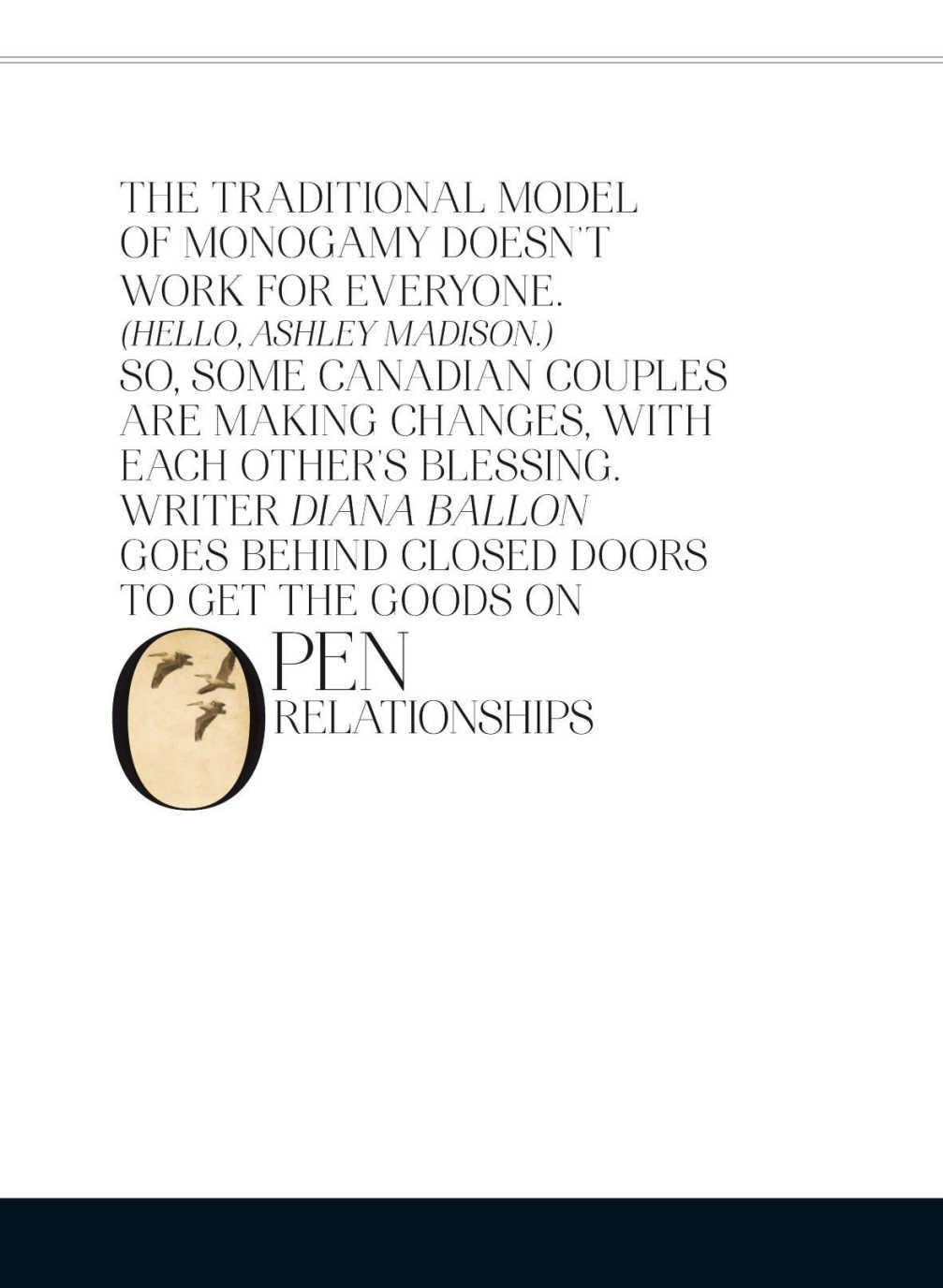
8 minute read
A LITTLE EXTRA ON THE SIDE
THE FACT THAT MADELEINE MAYNARD, A 31-year-old Toronto cross-stitch artist, uses the dating site OKCupid and the Tinder app to find men and women for hookups doesn’t mean she’s not committed to her long-term partner. In fact, she and George,* her boyfriend of four years, plan to marry.
Madeleine and George’s romantic life might sound complex – or even strange – but they’re part of a growing number of couples that are “opening up” their relationships. The decision to choose consensual non-monogamy as a way to make a relationship work is experiencing a surprising uptick in popularity. As many as 10 percent of all committed relationships, including marriages, now identify as open, according to Susan Pease Gadoua and Vicki Larson in their book, The New “I Do”: Reshaping Marriage for Skeptics, Realists and Rebels. The authors suggest that couples that are facing affairs or stuck in sexless marriages might benefit from long-term non-monogamy.
Advertisement
The conversation seems particularly timely in the wake of the Ashley Madison scandal last summer, when countless marriages were potentially shattered after the 30 million plus registered members’ names were exposed online. Unlike in open marriages, Ashley Madison users were hiding their indiscretions from their “loved ones” – a betrayal that can be costly.
As the breach of the famous cheating site pointed out, extramarital affairs are more
prevalent than many of us think. Statistics on infidelity vary, along with how people define infidelity (does watching porn, or sexting count?), but anywhere from 25 to 70 percent of people in committed relationships step out on their spouses, say Pease Gadoua and Larson. Since 30 to 50 percent of marriages end in divorce, with an affair often cited as a contributing factor to the downfall of a relationship,is it possible that people in open marriages are on to something?
Changing the rules of traditional marriage and monogamy isn’t easy, though. Nor is it for everyone. With no social model for the most successful or most acceptable way to practise opening up a relationship and no one way of doing it, couples are left to carve out new territory.
BEHIND CLOSED DOORS

“Open” takes many different forms. With polyamory, one of the primary goals may be emotional intimacy (and everyone knows about each other and may be friends), or perhaps a couple is exploring it to meet other needs or explore their sexuality explains Elisabeth Sheff, author of The Polyamorists Next Door: Inside Multiple-Partner Relationships and Families. With swinging, couples are typically in their 30s or 40s and older – it’s older couples who are more likely to afford the up-to-$150 fees to get into swinger clubs, says Sheff. Swingers (mostly a ’70s term) tend to be in more long-term, committed relationships and have sex without developing emotional intimacy with others outside the couple. Hookups often occur at parties, conventions, clubs or other group settings. “Monogamish” is the term used to describe couples that give each other a little wiggle room, the freedom to, say, sleep with someone at a conference or get together with an ex. Some have a “don’t ask, don’t tell” motto, while others require full permission beforehand or prefer being told about encounters after the fact.
Madeleine’s relationship might best be described as polyamorous. A typical week for Madeleine consists of a couple of overnights with her secondary (a relationship of almost a year with a single man), sometimes one night with someone she has met online, and the rest with her primary, George. (George also sees other people, when he is not with Madeleine.) Ideally, they’d like to find a couple or single person they can date together, but she describes what they have as the “next best thing.”
For Hilary,* a 43-year-old Toronto professional with a PhD, two young kids and a husband of more than 10 years, her marriage looks more like polyandry: Hilary’s husband has given her permission to see other people on the side (he isn’t jealous) but has agreed not to see other people himself (she is jealous). Her hookups are mostly with old friends or exes that she has reconnected with on Facebook – never with strangers. Usually the relationships consist of a few sexual encounters and vary in length and intimacy from a couple of hours in a hotel to an overnight to an encounter at a work-related function. Usually it’s about the sex, but in one case, she went as someone’s date to a wedding.
CAN IT WORK – REALLY?
Philippa Klein, a Montreal-based counselling therapist, doesn’t see any reason why open marriages can’t work if the relationship is healthy but acknowledges that having more than one sexual partner can be, well, complicated.
“What we do know is that cheating is absolutely detrimental to a marriage,” says Klein. People often feel traumatized and discredited by the lying and begin to question whether the love they thought they shared was ever even real.
For Madeleine, cheating is out of the question, but having multiple partners – in an open way with her partner –is simply a normal part of her lifestyle. It’s not about feeling unfulfilled.
“My needs are absolutely met by George – sexually and emotionally – but being in a relationship with just one person doesn’t make sense to me,” she says. “It boggles my mind that people settle down with one person at a time. I’m a very loving, very affectionate person.
And I’ve always been very sexually charged. I like to have fun with people. Everyone I sleep with tells me how beautiful I am. I’ve never been so confident in my life.”
Hilary’s relationships have been more fraught. In one case, she got so emotionally involved with a man that his distancing left her quite depressed. Although her husband tried to support her through this crisis, he was bothered that her preoccupation with this man took her emotionally away from their family and marriage.
KEYS TO SUCCESS
Experts agree that how successful a couple is in an open relationship is less about the type of relationship and more about how emotionally honest the partners are with each other. Both must feel safe to express feelings of jealousy or fear of abandonment and find a way to work through these together, says Klein. “Every time you add a moveable piece, you complicate the relationship,” she says. “If you don’t integrate other partners over the long term, each relationship can end up in a silo and create problems.” For example, one partner could start fantasizing that you love the other person more or that you do things with the other person that you don’t do together. These different parts of your life have the ability to leave you feeling disconnected.
While Madeleine and George “opened up” their relationship early on, they quickly decided to close it back up for a few years until they felt stronger as a couple and could set some ground rules. “Trust and communication are so important,” says Madeleine.
They talk about their relationships. At times, George gets jealous, and she admits to sometimes getting envious
when he describes having had good sex or a good date. But they work through these issues. Some of the rules they’ve established are that they agree to use protection, even for oral sex, and that Madeleine gives George the name, address and phone number of where she’s going when it’s a first date and when she plans to be home.
Hilary and her husband have never set rules for how her extramarital relationships unfold, but they discuss issues as they arise. And, despite the heartache she has already confronted, she admits she probably won’t stop seeing other people.
“Saying yes to opportunities has become a thing for me,” Hilary says. “I believe that you grow and learn from all your experiences, and relationships are a huge part of that.”
Even when couples are able to create a dynamic that works for them, external pressures can prove powerful. According to Pease Gadoua, our culture looks down on people having multiple partners, even when all the adults involved are aware and consenting.
Hilary and her husband have told some of their friends about Hilary’s outside relationships, but they haven’t told their kids. “I don’t want my children to know: There’s a level of complexity involved with having more than one relationship, even for me as an adult,” says Hilary. “I don’t expect them to understand this, but we do talk to them about all kinds of families and relationships.”
Madeleine and George have both indicated “open relationship” as their status on Facebook. Although George hasn’t told his co-workers, they’re completely open about their extracurricular relationships otherwise. Madeleine feels lucky to have family members who are comfortable with her choices. Her mother told her recently, “Madeleine, I don’t understand your lifestyle, but I’ve never seen you so happy, so keep doing what you’re doing.” bh

*Names have been changed.
S O , I H AV E S O ME T HIN G T O T E L L Y O U …
Sharing this facet of your relationship with friends and family can be tricky. We asked Elisabeth Sheff, author of The Polyamorists Next Door: Inside Multiple-Partner Relationships and Families, for her top three tips.
1. START WITH A SAFE BET Begin with your most understanding friend or open-minded relative. “If that favourite sibling, auntie or cousin understands and can be an ally, she could chime in with support if someone else freaks out later,” says Sheff. If you are concerned about someone’s judgment, try gauging how that person might react by asking her opinion about same-sex marriage or other sexualminority issues. If you think the person will be critical but still wish to tell her, plan what you’re going to say before you talk, including responses to her criticism.
2. SPEAK CONFIDENTLY When you tell friends, family or colleagues, do it without shame and let them know how happy your arrangement is making you –(hopefully) they’ll react better that way. But keep in mind that in some cases, there may be no possibility of a positive reaction.
3. DECIDE ON THE DETAILS AHEAD OF TIME Think about what you’re comfortable sharing and don’t reveal more than that. “You can answer questions about motivations, love and relationship boundaries without sharing intimate details,” says Sheff. And when you do disclose, be clear about whether the person is free to repeat what you’ve said to others.










